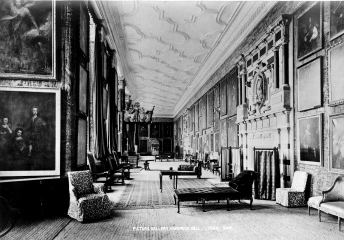 | ||
In architecture, a long gallery is a long, narrow room, often with a high ceiling. In Britain, long galleries were popular in Elizabethan and Jacobean houses. They were often located on the upper floor of the great houses of the time, and they stretched across the entire frontage of the building. They served several purposes: they were used for entertaining guests, for taking exercise in the form of walking when the weather was inclement, and for displaying art collections.
A long gallery has the appearance of a spacious corridor, but it was designed as a room to be used in its own right, not as a means of passing from one room to another. In the 16th century, the seemingly obvious concept of the corridor had not been introduced to British domestic architecture; rooms were entered from outside or by passing from one room to another.
Later, long galleries were built in Victorian houses, such as Nottingham Castle.
Notable long galleries in the United Kingdom can be seen at:
